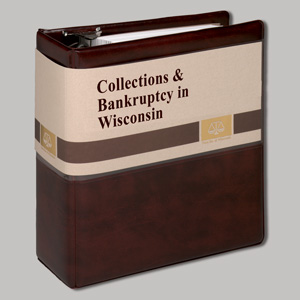
In February 2020, Timber Milling and Kiln LLC (TMK) became the first small business in Wisconsin to file a petition for relief under subchapter V of chapter 11 of the U.S. Bankruptcy Code (which appears at title 11 of the U.S. Code). Less than six months later, its plan of reorganization was confirmed consensually, making TMK the first example in Wisconsin of a small business effectively using these new provisions to streamline reorganization and avoid the expense of a full-blown chapter 11 proceeding.
Subchapter V was created in the Small Business Reorganization Act of 2019 and became effective on Feb. 19, 2020. Among other things, the subchapter V provisions (which are at 11 U.S.C. §§ 1181-1195) eliminate committees, grant the debtor the exclusive right to propose a plan, modify the requirements for nonconsensual confirmation, and allow the payment of administrative claims over the life of the plan. This article provides an overview, to help bankruptcy lawyers navigate the procedural and substantive requirements for the benefit of small-business debtors; and highlights some aspects from TMK’s bankruptcy case.
Small Business Reorganization Election and Participants
The Election. A small business debtor is one with no more than $2,725,625 of debt, although the CARES Act has temporarily increased the limit to $7.5 million.1 A qualifying debtor can elect to proceed under subchapter V in its petition for relief; if it does not, it must follow the more cumbersome small-business provisions of chapter 11.2
 Paul G. Swanson, U.W. 1979, is a partner of Steinhilber Swanson LLP, Oshkosh. He has been a Chapter 7 panel trustee for the Eastern District of Wisconsin since 1982 and is board certified in business and consumer bankruptcy. He represents debtors in complex reorganizations, and has extensive experience representing debtors and creditors in all aspects of cases in chapters 7, 11, 12 and 13 of the Bankruptcy Code and in adversary proceedings. He is the past president of the National Association of Bankruptcy Trustees; past chair of the American Bankruptcy Institutes Central States; past chair of the State Bar of Wisconsin’s Bankruptcy, Insolvency & Creditors’ Rights Section; and past president of the State Bar of Wisconsin.
Paul G. Swanson, U.W. 1979, is a partner of Steinhilber Swanson LLP, Oshkosh. He has been a Chapter 7 panel trustee for the Eastern District of Wisconsin since 1982 and is board certified in business and consumer bankruptcy. He represents debtors in complex reorganizations, and has extensive experience representing debtors and creditors in all aspects of cases in chapters 7, 11, 12 and 13 of the Bankruptcy Code and in adversary proceedings. He is the past president of the National Association of Bankruptcy Trustees; past chair of the American Bankruptcy Institutes Central States; past chair of the State Bar of Wisconsin’s Bankruptcy, Insolvency & Creditors’ Rights Section; and past president of the State Bar of Wisconsin.
 Peter T. Nowak, U.W. 2020 cum laude, is an associate at Steinhilber Swanson LLP, Oshkosh. During law school, he worked as an intern for the Wisconsin Supreme Court and the Internal Revenue Service. He is a member of the State Bar of Wisconsin’s Bankruptcy, Insolvency & Creditors’ Rights Section and Young Lawyers Division.
Peter T. Nowak, U.W. 2020 cum laude, is an associate at Steinhilber Swanson LLP, Oshkosh. During law school, he worked as an intern for the Wisconsin Supreme Court and the Internal Revenue Service. He is a member of the State Bar of Wisconsin’s Bankruptcy, Insolvency & Creditors’ Rights Section and Young Lawyers Division.
Lawyers for small-business debtors should hire a well-qualified financial advisor immediately after filing the bankruptcy petition, with an application to employ filed alongside your own. This professional is essential to the success of the proceeding and, ideally, the financial advisor will have formulated the outline of a feasible plan before the case is filed.
If the debtor elects to proceed under subchapter V, it must file its most recent tax return and financial statements on the docket.3 Additionally, among other things, the debtor must attend the initial debtor’s interview with the United States trustee (UST); timely file schedules, monthly operating reports, and tax returns; obtain and provide proof of insurance; and allow for inspection of its business operations.4
The Subchapter V Trustee. Shortly after the petition is filed, the UST will appoint a subchapter V trustee.5 Although the UST can appoint a standing trustee, most Wisconsin subchapter V trustees are seasoned business attorneys who serve as trustees on a case-by-case basis.
The duties of a subchapter V trustee are similar to those of trustees under chapters 12 and 13.6 However, the most important duty – unique to subchapter V – is facilitating the development of a consensual plan of reorganization.7 For that reason, the debtor’s lawyer should brief the trustee soon after the trustee is appointed, providing an outline of a plan and explaining why it will work, so the trustee can be used as an advocate. Creditors will also lobby the trustee, arguing that the debtor suffers from “terminal euphoria” (a term coined by Len Leverson). The debtor’s lawyer should be prepared to ask the trustee to take on a positive, hands-on role if possible. The Bankruptcy Code does not define “facilitate,” so a large canvas exists upon which to paint.
The subchapter V trustee is compensated under 11 U.S.C. § 330, which provides for reasonable compensation for services rendered. Accordingly, the debtor pays for the trustee’s services, and these costs must be contained in the debtor’s plan. The trustee’s claim has the same priority as the claim of debtor’s counsel, so the debtor’s lawyer should be aware of the total amount of all fees generated by administrative claimants. Importantly, subchapter V administrative claims, unlike regular chapter 11 administrative claims, can be paid over the life of the plan.8
Debtor in Possession. A subchapter V debtor operates as a debtor in possession, with similar rights and duties as in a debtor-in-possession proceeding under chapter 11.9 The debtor in possession can be removed for cause, at which point the subchapter V trustee would operate the business (assuming the plan has not been substantially consummated and the trustee dismissed).10
As a practical matter, many debtors are troubled businesses with inadequate financial management. The debtor’s counsel must focus the debtor to operate efficiently and exercise financial discipline. Also, counsel must ensure that the financial advisor or the debtor’s bookkeeper is complying with UST reporting requirements and deadlines. The court will insist that reports are completed, and the trustee will expect timely information concerning the debtor’s operations.
Small Business Reorganization Process
Property of the Estate. Upon the filing of a petition, the debtor’s pre-petition property becomes property of the debtor’s estate.11 However, post-petition property and earnings only become property of the estate if the debtor’s plan is confirmed.12 If the case were converted to one under chapter 7 of the Bankruptcy Code, the property or earnings acquired post-petition would likely become property of the debtor’s estate, to the detriment of any secured creditor holding a pre-petition security interest. Secured creditors will likely insist that the debtors provide adequate protection by granting the creditors a post-petition security interest in the after-acquired property.
Status Conference. A unique provision of subchapter V requires the court to convene a status conference within 60 days after the petition date to “further the economical and expeditious resolution of the case.”13 Additionally, the debtor must file a report informing the court of its efforts to obtain a consensual plan of reorganization at least 14 days before the status conference.14 The conference and report allow the debtor to foreshadow its plan and keep the court attuned to the case, which happens little under chapter 11.
The Plan. Only the debtor may propose a plan under subchapter V, but the debtor must file the plan within 90 days after the petition date.15 The debtor may modify the plan any time before confirmation and, if necessary, the court may extend the deadline “if the need for the extension is attributable to circumstances for which the debtor should not be held accountable.”16 This tight timeline requires that a reasonably workable plan be in place going into the case (which again signals the importance of hiring financial advisors who can provide solid financial analysis and projections). This preparedness also places debtors’ counsel in a better position to negotiate treatment of various claims before confirmation, with the goal of confirming a consensual plan.
The Bankruptcy Code imposes three statutory requirements for the plan, and the U.S. Bankruptcy Courts for the Eastern and Western Districts of Wisconsin provide on their websites sample forms for debtors’ proposed plans.17 First, the plan must include a brief history of the debtor, a liquidation analysis, and financial projections indicating the debtor’s ability to make payments under the plan. Second, the plan must devote a submission of future earnings to fund the plan. Third, for individual debtors, the plan may modify the treatment of debts secured by a lien on the debtor’s principal residence but only if proceeds from the loan were used in the business and not primarily to acquire the residence.
Unlike in chapter 11 generally, the debtor is not required to include a disclosure statement with the plan, absent court order. Thus, the plan should include information regarding the debtor’s history, organization, and finances. This is the portion of the plan in which the debtor can “sell” the plan and project the business’s future performance.
Learn More about Collections and Bankruptcy
 Recently updated, PINNACLE’s® Collections & Bankruptcy in Wisconsin includes valuable information regarding new legislation allowing for small-business-debtor reorganizations. A new section discusses the provisions for these reorganizations, including qualification requirements, whether the process is mandatory, and how the reorganization process has been streamlined by the new legislation.
Recently updated, PINNACLE’s® Collections & Bankruptcy in Wisconsin includes valuable information regarding new legislation allowing for small-business-debtor reorganizations. A new section discusses the provisions for these reorganizations, including qualification requirements, whether the process is mandatory, and how the reorganization process has been streamlined by the new legislation.
Practical, insightful, and easy to navigate,Collections & Bankruptcy in Wisconsin is available via the State Bar of Wisconsin PINNACLE® subscription-based online library Books UnBound® at $180 members/$225 nonmembers. The print book is $166 members/$210 nonmembers.
Small Business Reorganization Plan Confirmation
Subchapter V provides for confirmation of consensual and nonconsensual plans, and the requirements for confirmation can be quite technical.
Consensual Plans. If all impaired creditors (that is, those whose rights are altered) accept the plan and it conforms to certain requirements of the Bankruptcy Code, the court may confirm the plan “consensually.”18 If the court confirms a consensual plan, the debtor’s debt is discharged except as provided under the plan, the trustee is dismissed after the plan is substantially consummated, and the debtor emerges from the bankruptcy process “reorganized.”19
Nonconsensual Plans or Cramdowns. The court can still confirm a plan without the consent of all impaired creditors if the plan meets certain requirements of the Bankruptcy Code, does not discriminate unfairly, and is fair and equitable to impaired classes that did not accept the plan.20 Subchapter V uses the same standard for unfair discrimination21 as chapter 11, but “fair and equitable” is defined22 and provides a similar standard to that used in the cramdown provisions of chapter 12 of the Bankruptcy Code.
No affirmative vote by any class is required, but priority taxes must be paid over a period no longer than 60 months from the filing date. This standard gives enormous discretion to the court but also burdens the debtor with demonstrating the fairness of treatment to unsecured creditors or dissenting secured claimants. Importantly, the absolute priority rule of chapter 11 – which prohibits distributions to classes junior to the objecting class (including equity retention) – does not apply.
The debtor and any secured creditors must agree to the terms. If they do not, the usual rules apply, which require that the interest rate, amortization period, and term of the loan square with the “market.” If a valuation hearing is required, the debtor’s counsel should hire the appraiser and file a valuation motion as soon as possible, given the compressed timeline to propose a plan.
For nonconsensual confirmation, the trustee serves for the duration of the plan period, collecting and distributing plan payments if necessary. The debtor will not receive a discharge until the completion of all plan payments within the plan period (three to five years).23
Activities After Confirmation
Post Confirmation. Not later than 14 days after the plan is substantially consummated, the debtor must file and serve on the UST, the trustee, and all parties in interest a notice of substantial consummation.24 If the plan is consensual, the trustee’s duties terminate upon substantial confirmation. But, if the plan is nonconsensual, the trustee serves throughout the life of the plan.
Modification of the Plan After Confirmation. The debtor may modify a consensual plan at any time after confirmation and before substantial consummation if circumstances warrant the modification and the court, after notice and hearing, confirms the modified plan consensually.25 This period might be short.
If the plan was confirmed nonconsensually, the debtor may modify the plan at any time within the plan period if circumstances warrant and the plan still meets the requirements for nonconsensual confirmation.26
The Case of TMK
TMK27 manufactures wood chunks for grilling and smoking food for barbeque enthusiasts. The business started with a great idea that was executed adequately, but the business was substantially undercapitalized. As a result, TMK entered into loan agreements with one of its customers, but the terms were highly unfavorable and deprived it of sufficient cash flow. These loans were the reason the business was going down in flames.
Negotiations to recapitalize the business failed when that customer – now the major secured creditor – insisted that its claim be paid in full and that TMK continue to provide its products at discounted rates (at cost) as required under the loan agreements. An angel investor loaned working capital on an unsecured basis pre-petition and agreed to provide post-petition secured financing. Accordingly, given the customer’s intransigence, TMK filed its petition for relief under subchapter V along with a motion to incur secured debt.
The process proved to be efficient and relatively inexpensive as compared to a regular chapter 11 proceeding, the cost of which TMK could not bear. Although the time between the petition date and plan confirmation was short, the debtor was able to obtain competent financial advice, formulate a plan of reorganization, and emerge from the process with a consensual plan. The status conference provided a welcome opportunity to present an outline of the debtor’s plan and brief the court on pending issues.
Notably, TMK upon filing applied to employ a financial advisor, who quickly identified problems, imposed financial discipline, implemented a financial management system, and developed and tested projections that underpinned the plan. TMK also used the subchapter V trustee to help facilitate a consensual plan of reorganization, which was nearly delayed by an adversary proceeding.
TMK, now reorganized, is growing and likely will need additional investment in the future, but it has a firm base from which it can operate. There is a rational financial plan in place, and financial discipline has been enforced. A fortunate consequence of the pandemic is that many people are cooking at home on their grills and smokers, and TMK has experienced an unprecedented demand for its products.
Could TMK have pushed for a better deal with a contested plan? Yes. But the process mitigates toward compromise. The customer may have been undersecured, but a valuation hearing would have been quite expensive and a battle to reclassify a portion of the debt did not make sense.
Conclusion
In our opinion, small-business debtors, like TMK, should elect to proceed under subchapter V if eligible. The new provisions facilitate a more efficient reorganization without the financial and procedural burdens of a regular chapter 11 proceeding.
Meet Our Contributors
What is the best career advice you ever received?
 I had the great luck to have worked right out of law school for my father, who did a fair amount of personal injury work. I also took public defender cases and got on the felony appointment list. As a result, I ended up doing jury trials early in my career.
I had the great luck to have worked right out of law school for my father, who did a fair amount of personal injury work. I also took public defender cases and got on the felony appointment list. As a result, I ended up doing jury trials early in my career.
I was preparing my first closing argument and asked for my father’s advice. I had written out what I thought was a convincing and persuasive plea to find liability and give my client real money. He read it over, looked up at me, and ripped it up. He noted that I knew the facts and the law and needed to talk to the jury directly, not read a prepared speech. He advised me to have a bullet point outline to guide myself through the argument but to talk directly to the jurors, look them in the eye, and convince them. I got a great result!
I also recall all the advice I got from opposing counsel while we went out to wait (usually at a bar) for juries to come back – invaluable critiques from older lawyers imparting wisdom to the kid – usually at the expense of my ego. I learned so much from them all. Great advice from great lawyers.
Paul G. Swanson, Steinhilber Swanson LLP, Oshkosh.
What was your favorite vacation?
 I enjoy following the Milwaukee Brewers to different major-league ballparks. Each year, my dad and I try to visit at least one or two new stadiums. Unfortunately, the pandemic made this impossible in 2020, but we look forward to traveling again in the (hopefully near) future.
I enjoy following the Milwaukee Brewers to different major-league ballparks. Each year, my dad and I try to visit at least one or two new stadiums. Unfortunately, the pandemic made this impossible in 2020, but we look forward to traveling again in the (hopefully near) future.
My favorite experience was visiting Fenway Park for the first time. Even though the first game of the series was rescheduled due to rain, it was an incredible baseball experience. I will not forget sitting in the old, wooden seats, walking along Yawkey Way, and eating a Fenway frank. The Brewers were swept, but our trip checked an item off the bucket list, and we have not missed a Brewers’ game at Fenway since.
Peter T. Nowak, Steinhilber Swanson LLP, Oshkosh.
Become a contributor! Are you working on an interesting case? Have a practice tip to share? There are several ways to contribute to Wisconsin Lawyer. To discuss a topic idea, contact Managing Editor Karlé Lester at (800) 444-9404, ext. 6127, or email klester@wisbar.org. Check out our writing and submission guidelines.
Endnotes
1 11 U.S.C. § 101(51D); CARES Act § 1113(a)(1); 11 U.S.C. § 1182(1). The temporary increase in the debt limit expires March 27, 2021. CARES Act § 1113(a)(5).
2 See, e.g., 11 U.S.C. § 1116; 11 U.S.C. § 1121(e); 11 U.S.C. § 1125(f).
3 11 U.S.C. § 1187(a).
4 11 U.S.C. § 1187(b).
5 11 U.S.C. § 1183(a).
6 11 U.S.C. § 1183(b)(1).
7 11 U.S.C. § 1183(b)(7).
8 11 U.S.C. § 1191(e).
9 11 U.S.C. § 1184.
10 11 U.S.C. § 1185.
11 11 U.S.C. § 541.
12 11 U.S.C. § 1186.
13 11 U.S.C. § 1188.
14 11 U.S.C. § 1188(c).
15 11 U.S.C. § 1189.
16 11 U.S.C. §§ 1193; 11 U.S.C. § 1189.
17 11 U.S.C. § 1190. For sample forms, see www.wieb.uscourts.gov/local-sample-forms (click on “Subchapter V Small Business Form” under “Chapter 11 Forms”) and www.wiwb.uscourts.gov/forms (click on “Subchapter V Small Business Form” under “Sample Forms”).
18 11 U.S.C. § 1191(a). Under this provision, the court must find that the plan meets the requirements of 11 U.S.C. § 1129, except subsection (15).
19 11 U.S.C. § 1141(d); 11 U.S.C. § 1183(c)(1).
20 11 U.S.C. § 1191(b).
21 11 U.S.C. § 1129(b)(1).
22 11 U.S.C. § 1191(c).
23 11 U.S.C. § 1192.
24 11 U.S.C. § 1183(c).
25 11 U.S.C. § 1193(b).
26 11 U.S.C. § 1193(c).
27 TMK’s managing member gave the authors permission to disclose the information in this article.
